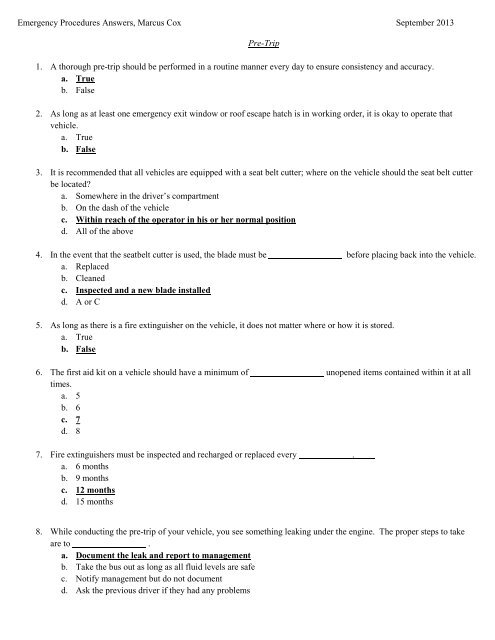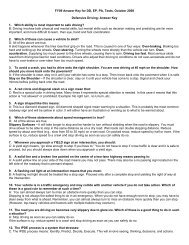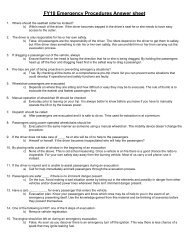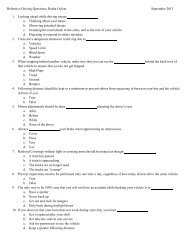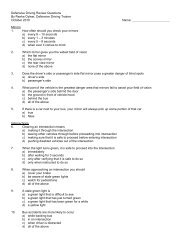RTAC Emergency Procedures Answer Sheet
RTAC Emergency Procedures Answer Sheet
RTAC Emergency Procedures Answer Sheet
Create successful ePaper yourself
Turn your PDF publications into a flip-book with our unique Google optimized e-Paper software.
<strong>Emergency</strong> <strong>Procedures</strong> <strong>Answer</strong>s, Marcus Cox September 2013<br />
Pre-Trip<br />
1. A thorough pre-trip should be performed in a routine manner every day to ensure consistency and accuracy.<br />
a. True<br />
b. False<br />
2. As long as at least one emergency exit window or roof escape hatch is in working order, it is okay to operate that<br />
vehicle.<br />
a. True<br />
b. False<br />
3. It is recommended that all vehicles are equipped with a seat belt cutter; where on the vehicle should the seat belt cutter<br />
be located?<br />
a. Somewhere in the driver’s compartment<br />
b. On the dash of the vehicle<br />
c. Within reach of the operator in his or her normal position<br />
d. All of the above<br />
4. In the event that the seatbelt cutter is used, the blade must be before placing back into the vehicle.<br />
a. Replaced<br />
b. Cleaned<br />
c. Inspected and a new blade installed<br />
d. A or C<br />
5. As long as there is a fire extinguisher on the vehicle, it does not matter where or how it is stored.<br />
a. True<br />
b. False<br />
6. The first aid kit on a vehicle should have a minimum of unopened items contained within it at all<br />
times.<br />
a. 5<br />
b. 6<br />
c. 7<br />
d. 8<br />
7. Fire extinguishers must be inspected and recharged or replaced every .<br />
a. 6 months<br />
b. 9 months<br />
c. 12 months<br />
d. 15 months<br />
8. While conducting the pre-trip of your vehicle, you see something leaking under the engine. The proper steps to take<br />
are to .<br />
a. Document the leak and report to management<br />
b. Take the bus out as long as all fluid levels are safe<br />
c. Notify management but do not document<br />
d. Ask the previous driver if they had any problems
9. Knowledge of the location and use of all on-board safety equipment can be invaluable in an emergency situation.<br />
a. True<br />
b. False<br />
10. The best time to find out that an emergency exit is not working is during an evacuation.<br />
a. True<br />
b. False<br />
Defensive Driving<br />
11. Defensive Driving is one of the first steps to take to help prevent an accident.<br />
a. True<br />
b. False<br />
12. Which of the following would best define Defensive Driving?<br />
a. One who will do everything possible to avoid a collision<br />
b. Driving to save lives, time, and money, in spite of the conditions around you and the actions of others<br />
c. Reducing the risk of driving by anticipating dangerous situations, despite adverse conditions or the mistakes of<br />
others<br />
d. All of the above<br />
13. Some of the ways that a professional operator can drive defensively include:<br />
a. Recognizing what may become a hazardous situation<br />
b. Scanning far enough ahead<br />
c. Being aware of the space around the vehicle at all times<br />
d. All of the above<br />
14. Which of these situations WOULD NOT require evacuation?<br />
a. Vehicular rollover<br />
b. Fire or smoke conditions<br />
c. Flat tire<br />
d. Vehicle immersion or submersion in water<br />
15. If any chemical smell is present in the vehicle, it is okay to continue driving until the smell can be clearly identified.<br />
a. True<br />
b. False<br />
<strong>Emergency</strong> Evacuation<br />
16. Paratransit vehicles burn quickly and intensely, and generate huge quantities of smoke with over<br />
types of toxic gases.<br />
a. 20<br />
b. 30<br />
c. 40<br />
d. 50
17. You should keep in mind the which holds that a clear aisle reduces accidents on-board the vehicle<br />
and facilitates a smooth evacuation.<br />
a. Open Walkway Concept<br />
b. Free and Clear Concept<br />
c. Clear Aisle Concept<br />
d. Up and Out Concept<br />
18. Your response to an emergency will be based on your knowledge of:<br />
a. The accident situation<br />
b. The characteristics of the riders on the vehicle<br />
c. The safety features and safety equipment on-board the vehicle<br />
d. All of the above<br />
19. If a smoke or fire condition is present or imminent, you should always:<br />
a. Attempt to put it out with your fire extinguisher<br />
b. Evacuate your passengers first to ensure their safety<br />
c. Contact dispatch to let them know that they need to contact the fire department<br />
d. None of the above<br />
20. In order to warn oncoming motorists that your vehicle is disabled, you need to place your warning devices (triangles):<br />
a. As soon as possible<br />
b. Within 10 minutes of pulling over, but only after you have ensured that your passengers are in a secure<br />
location<br />
c. They do not need to be set up<br />
d. Once emergency personnel have arrived on scene<br />
21. If no imminent danger is present, the safest place for the passengers is .<br />
a. A safe distance away from the vehicle<br />
b. Inside a building<br />
c. To remain on the vehicle<br />
d. None of the above<br />
22. Wheelchair lifts should only be used in an evacuation when .<br />
a. There is more than one passenger using a wheelchair or other mobility device<br />
b. Operated manually and no other viable option is available<br />
c. The passenger requests it<br />
d. None of the above<br />
23. If faced with an emergency evacuation, the operator needs to assume a leadership role and remain<br />
and .<br />
a. Firm, Aggressive<br />
b. Calm, Composed<br />
c. Seated, Quiet<br />
d. Outspoken, Blunt<br />
24. If an unconscious passenger needs to be evacuated using the shoulder drag, the passenger’s should<br />
be pointed in the direction of the exit location.<br />
a. Feet<br />
b. Head<br />
c. It doesn’t matter how they are positioned<br />
d. A or B
25. Passengers who use mobility devices should be evacuated first.<br />
a. True<br />
b. False<br />
26. In the event that a vehicle were to break down on a road in which the flow of traffic was all headed in the same<br />
direction, the triangles should be placed:<br />
a. Two triangles behind the vehicle and one triangle in front, all at appropriate distances<br />
b. Three triangles in front of the vehicle, all at appropriate distances<br />
c. Three triangles behind the vehicle, all at appropriate distances<br />
d. Two triangles in front of the vehicle and one triangle in back, all at appropriate distances<br />
27. When evacuating passengers out of a window, put their out of the window first.<br />
a. Feet<br />
b. Head<br />
c. Hips<br />
d. Body<br />
28. An operator should always evacuate every passenger on board their vehicle during an emergency, even if it means<br />
attempting a maneuver that they do not have confidence that they can perform.<br />
a. True<br />
b. False<br />
29. It may be necessary to physically remove a person from a vehicle in order to save his or her life.<br />
a. True<br />
b. False<br />
30. If a service animal is on-board, evacuate the first and then .<br />
a. Service Animal, the passenger whose animal it is<br />
b. Passenger whom the animal assists, the animal<br />
c. A or B<br />
31. An operator should always know how many passengers are on-board their vehicle at all times in order to:<br />
a. Understand what types of assistance may be needed if an evacuation occurs<br />
b. Verify that no riders are remaining on-board if an evacuation occurs<br />
c. Explain important information to emergency personnel if an evacuation occurs<br />
d. All of the above<br />
32. If an emergency evacuation were to occur, at minimum the information relayed to dispatch or emergency personnel<br />
should be:<br />
a. Operator name and vehicle number<br />
b. Current location including concise description of the emergency<br />
c. A request for police and ambulance help<br />
d. All of the above<br />
33. The better the description relayed to the dispatcher, the quicker and better the response will be from emergency<br />
preparedness forces.<br />
a. True<br />
b. False
34. When emergency responders arrive on-scene, you should:<br />
a. Be cooperative<br />
b. <strong>Answer</strong> all of their questions<br />
c. Provide them with all of the information appropriate to facilitate evacuating any remaining passengers<br />
d. All of the above<br />
35. During an evacuation, which passengers should be evacuated first?<br />
a. Visually impaired passengers<br />
b. Mobility impaired passengers<br />
c. Ambulatory passengers<br />
d. The order does not matter<br />
36. It is okay to request assistance from a passenger during an evacuation.<br />
a. True<br />
b. False<br />
37. The driver should speak loud and when giving instructions during an evacuation.<br />
a. Firm<br />
b. Clear<br />
c. Without panic<br />
d. All of the above<br />
38. When placing multiple mobility devices in the vehicle, evacuation should not be a factor in where they are positioned.<br />
a. True<br />
b. False<br />
39. The first thing an operator should do once an accident has occurred is to contact dispatch to let them know.<br />
a. True<br />
b. False<br />
40. Which of the following WOULD BE cause for evacuation?<br />
a. Vehicle rollover<br />
b. Fire or smoke conditions<br />
c. Submersion in water<br />
d. All of the above<br />
41. If a vehicle becomes fully engulfed in smoke and there are still passengers on the bus, it is the operator’s responsibility<br />
to go back on the vehicle to remove them.<br />
a. True<br />
b. False<br />
42. During an evacuation, riders should be moved to .<br />
a. Another vehicle once it arrives<br />
b. A safe distance away from the vehicle<br />
c. A safe distance away from the vehicle, far enough away so that an explosion will not injure evacuated<br />
passengers<br />
d. All of the above
43. Depending on the physical limitations of an operator, it is okay to assist passengers to a nearby location to expedite the<br />
evacuation process; the riders could then be moved to a more secure location at a later time.<br />
a. True<br />
b. False<br />
44. The best exit to use during an evacuation is .<br />
a. The closest exit<br />
b. The largest exit<br />
c. The exit that can be opened and will remain available during the evacuation process<br />
d. Any of the above<br />
45. is much more deadly then .<br />
a. Fire, smoke<br />
b. Smoke, fire<br />
46. When an evacuation is imminent, the driver should and the evacuation.<br />
a. Take charge, lead<br />
b. Panic, ignore<br />
c. Exit the vehicle, yell directions to the passengers from outside of the vehicle about<br />
d. Ask questions, frantically contact dispatch to tell them about<br />
47. It is the responsibility of the to ensure the safety of the individuals on board the vehicle.<br />
a. Operator<br />
b. Other passengers<br />
c. Passengers themselves<br />
d. None of the above<br />
48. When assisting in an evacuation, always remember your own .<br />
a. Family<br />
b. Control<br />
c. Passengers<br />
d. Strengths and limitations<br />
49. If fire is present, pull over to the side of the roadway, turn off the vehicle, and place the radio/cell phone outside of the<br />
vehicle to be used to contact dispatch after the evacuation has occurred.<br />
a. True<br />
b. False<br />
50. YOU are responsible for ensuring the safety of your passengers during an evacuation.<br />
a. True<br />
b. True


